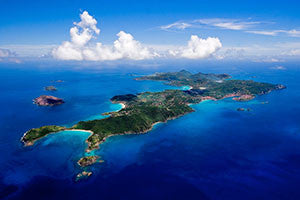10 Fun Facts about St. Barths
In honor of our new theme -- Welcome to St. Barts - we wanted to share some interesting facts about St. Barths and its rich history.

1.The flag of St. Barths (besides the French flag colors) is composed of the Lily flower – a reminder that it belongs to France, the Maltese cross – referring to possession by the Order of Malta, the crown – symbolism of the Swedish period, and lastly the Pelican as their emblem (the Pelican which is also on the St. Martin flag, means that you would want to fly from one island to another to discover new treasures.)
2. The biodiversity of St. Barth's and the surrounding islands have: 183 different species of fish, 54 varieties of coral, and 60 types of sea sponges.
3. St. Barths was originally called “Ouanalao” by the Arawaks (original island inhabitants) in 1493. Columbus discovered St. Barths and named the island after his brother, Bartolomeo.
4. The island was discovered in 1493 by Christopher Columbus who named it for his brother Bartolomeo. St. Barthelemy was first settled by the French in 1648. In 1784, the French sold the island to Sweden, who renamed the largest town Gustavia, after the Swedish King GUSTAV III, and made it a free port; the island prospered as a trade and supply center during the colonial wars of the 18th century. France repurchased the island in 1878 and placed it under the administration of Guadeloupe. St. Barthelemy retained its free port status along with various Swedish appellations such as Swedish street and town names, and the three-crown symbol on the coat of arms. In 2003, the populace of the island voted to secede from Guadeloupe and in 2007, the island became a French overseas collectivity.
5. French is the official language, but English is widely spoken.
6. Despite limited rain in St. Barths, there is still plenty of vegetation. The west coast is drier with shrubs and cacti, the East coast is greener with more tropical vegetation like floral species which adorn the landscape.
7. Tourism took hold in St. Barths when Rémy de Haenen, an eccentric Dutch aviator, landed his plane at what is now the airport. He later became the first hotelier and the island's mayor.
8. The island gets more than 300 sunny days a year on average.
9. The glamorous island of St Barts is one of the Caribbean's top beach destinations. Ringing the island are immaculate strips of sand and ethereal turquoise waters. The shallow reefs that encircle the island help to protect these renowned beaches, and they also provide excellent snorkeling and diving opportunities.
10. This volcanic island without any rivers forced the population to adapt to its rigors in order to here live comfortably. Fresh water in St Barts comes from a desalination plant or large cisterns built into villas and hotels to collect rainwater. Thus water is a valuable resource to be used carefully.

Continue reading

